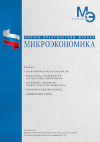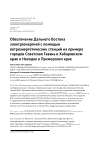Electricity supply in the Far East by means of wind power stations on the example of the towns of Sovetskaya Gavan in Khabarovsk Krai and Nakhodka in Primorsky Krai
DOI: 10.33917/mic-3.122.2025.110-118
The article considers the possibility of energy supply of the port cities Sovetskaya Gavan in Khabarovsk Krai and Nakhodka in Primorsky Krai using wind power plants (WPP). The wind potential of the regions has been analyzed, promising sites for wind power plants (WPP) have been identified, and their expected output has been calculated. The technical and economic aspects of the projects have been studied. It is shown that the introduction of wind power plants and energy storage systems (ESS) can reduce the dependence of the regional economy on traditional energy sources, reduce greenhouse gas emissions and ensure sustainable energy supply. Recommendations on project implementation are given, taking into account climatic peculiarities and infrastructural limitations.
References:
1. Elistratov V.V. Renewable energy. St. Petersburg: Peter the Great St. Petersburg Polytechnic University, 2016. 424 p.
2. Lukutin B.V. Renewable energy in decentralized power supply / B. V. Lukutin, O. A. Surzhikova, E. B. Shandarova. Moscow: Energoatomizdat, 2008. 231 p.
3. Resources and efficiency of renewable energy sources utilization in Russia / P. P. Bezrukikh, Y. D. Arbuzov, G. A. Borisov [and others]. Saint-Petersburg: «Publishing house “Nauka”», 2002. 314 p.
4. Goldwind GW 171/6250 – 6.25 MW – Wind turbine. URL: https://en.wind-turbine-models.com/turbines/2401-goldwind-gw-171-6250
5. Russian renewable energy market: current status and development prospects (2023 – 1H 2024) – ARWE. URL: https://rreda.ru/upload/iblock/c86/
6. Faster and more scarce – JSC System Operator of the Unified Energy System. URL: https://www.so-ups.ru/news/press/press-view/news/26721/
7. Natural gas tariffs and prices for legal entities – Gazprom Mezhregiongaz Dalniy Vostok. URL: https://mrgdv.ru/yuridicheskim-licam/tarify-i-ceny/?ysclid=m9iamg1ov439363131
8. 4 projects of Inter RAO, En+ and TGK-14 for 780 MW were selected at the repeated COM of NGOs in Siberia. URL: https://peretok.ru/news/strategy/28043/?ysclid=m9icjc92wi957143661
9. Ilkovsky K.K. Sunlight against coal / K. K. Ilkovsky, D. K. Ilkovsky. Economic Strategies. 2020;22 (3(169)):134-144.





